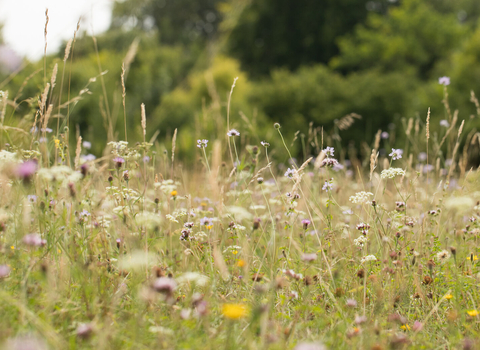Wildflower meadows
Britain’s meadows hum with life - from the first flowers of spring to misty autumn days when birds flock to berry-laden hedges. Whether it is a blaze of yellow from cowslips or the whirr of grasshoppers and crickets – colours and sound fill the senses.
Tragically, we have lost 97% of our wildflower-rich grassland since the 1930s as farming practices have changed and towns and villages have expanded. Luckily some farmers and conservation charities work hard to maintain these precious species-rich habitats.
Lincolnshire Wildlife Trust manages many ancient and new meadows as nature reserves, and often these are the best and last remaining examples in the county. We ask that in the summer months, people keep to paths at the edges of fields to avoid trampling wildlife. The view is just as good from there!
Red Hill Nature Reserve & Wildflower Coronation Meadow (https://vimeo.com/195604060)
Lincolnshire Wildlife Trust
Find a wildflower meadow near you
What to look for
Summer is the peak time for wildflower meadows, when whole hillsides are alight with colour and thrumming with insects. While the flowers may be the stars of the show, don't forget the insects. Butterflies, like the dark green fritillary, the day-flying burnet moth and marbled white are now common place at Red Hill nature reserve.
Bumblebees are seen laden with pollen, and if there is water nearby it's possible that dragonflies and damselflies will also be zipping through the meadow. Song birds such as chiffchaff, skylark, blackcap and wren sing proudly from the treetops and reptiles such as grass snakes and common lizards can be seen basking in the sunshine.
Remember it’s not just about the colour. Wildflowers have a subtle sweet scent: get down and take a deep sniff too!
Learn more about meadows
What is a wildflower meadow?
A wildflower meadow is an area of grassland that is cut in the summer and grazed through autumn and often winter. It's the crop of hay that makes a meadow what it is.
The romantic image of a flowery field is the result of the need for hay. As much as it was part of the landscape, it was also a vital part of the economy. Perhaps before the advent of the car, it was hay not petrol that helped fuel the nation's transport - hay meadows providing winder feed for horses and livestock.
Why do meadows have to be cut?
If a meadow isn't cut, coarser grasses and eventually shrubs like hawthorn will take over. After a longer period of time, the meadow would eventually develop into woodland. Equally, if the meadow is cut too frequently the flowers won't have time to grow and their seeds will not develop, having a knock-on effect for the invertebrates which rely on them.
If the hay isn't removed after cutting, the soil will become more fertile and encourage growth of more competitive plants such as docks, thistles and nettles, which although have their own ecological benefits, will not give the rich biodiversity that a meadow provides.
When is a flowery field not a meadow?
Pasture
Cattle and sheep graze freely on pasture but rarely over-winter. Pastures often have flowering plants that are unpalatable or can cope with frequent grazing, for example buttercup and daisy. Over-grazing can create a very short sward punctuated by inedible thistle, nettle and ragwort.
Downland
In the Middle Ages when England's prosperity depended largely on wool, the chalk downlands of the Wolds were grazed by sheep. These typically have thin, stony soils that are hard to work. Those that survive tend to be on steeper hillsides and wider road verges.
Cornfield annuals
Often marketed in seed mixes as 'meadow' flowers, these are weeds of arable cropping that grow new plants every year on land that has been dug over or cultivated. Annuals, plants that live for one year, flourished in crops until the advent of modern herbicides. In a garden they make a good splash of colour for one year but will have to be re-sown to create the effect again. Examples of cornfield annual species includes cornflower, corncockle, corn marigold and common poppy.
Pictorial meadows
These are flower mixes frequently used in urban areas. Typically, they have a riot of colour and are usually made up of species from around the world. They look great and provide a source or pollen and nectar for insects, but are less likely to provide food for the larval stages and should not be planted in the countryside. Pictorial meadow species includes Californian poppy, Shirley poppy and red flax.
Create your own wildflower meadow
Download our Meadow Booklet for helpful advice on meadow creation and management - from selecting the seeds to using the right tools for the job; and our handy Meadow Calendar, a helpful table showing the best times to seed, plant and cut. For more information, head over to our Wildflower Meadow Hub page.
Wildflower ID guides
These free Wildflower Identification Guides were designed and produced by the 'Life on the Verge' project. Each guide was used by volunteers to identify significant wildflowers which indicate grassland of good quality in the East Midlands. Choose your region below for a list of the wildflowers you're most likely to come across.
Roadside Nature Reserves
One of the most pleasing aspects of the Lincolnshire countryside is the wide verges along many of the roadsides. They are havens for a variety of invertebrates and small mammals, and in summer they are coloured with many kinds of wildflowers.
There are 65 Roadside Nature Reserves (RNRs), covering either both sides of the road or only one side, which total a distance of over 80 kilometres (50 miles). Click on the link below to find out more information or for a list of all Lincolnshire's RNRs, or take a look at our road verge biomass harvesting FAQs to find out how we're managing some of them more economically.

















